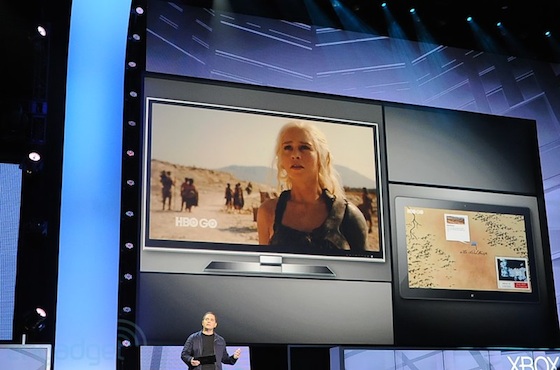
SmartGlass lets your tablet become a secondary display in supported Xbox games. (Image via Engadget)
Once upon a time, home video games were a ball bouncing around hitting a moving paddle or a tank shooting at an opponent tank where the gaming console was connected to your home television. Color wasn’t even a given on that set, where black and white or shades of gray was more than enough. Fast forward quite a few years and things haven’t changed that much, as you’re still connecting the gaming consoles to the television. It is just the TV is now HD, providing you with a much stronger graphics palette. The tank battles have gotten a little more complicated thanks to the richer hardware capabilities of today’s machines, but it is still pretty much the same contest: killing an opponent and capturing a “flag” for the reward or just scoring more points.
One of the leading gaming consoles today is the Xbox, coming out of Microsoft. According to a recent earnings report, Microsoft has sold 70 million units of this console. It is not your typical console any more though. It provides an HDMI connector to your HDTV, allowing that “big basketball game” to be seen and heard on an HD television. In addition to hooking up your Xbox to your television, Microsoft has created a sort of companion program that runs on nearly all the latest phones, tablets and Windows-based computeroperating systems out there. Throw in Android, iOS and Windows Phone, and you have hit a large portion of your available audience. This companion program is called SmartGlass.
SmartGlass connects to your Xbox 360 and turns any compatible device into either an output source for media or, more importantly, a real controller for your Internet connectivity through the Xbox. Think of it as a secondary display. For instance, while playing a war game, you might want to see a map. Previously, you would have needed to “pause” the live action within the game and popped up a map on your TV over the game. Now, with SmartGlass, there is no pausing. Just look (quickly) at your device running the SmartGlass application and the map will always be there, tracking your location in the game as you roam around. When watching a DVD on the console, running SmartGlass on your device presents information about the show’s actors and sound tracks. It even acts as the cursor when running the newly integrated Internet Explorer.
Probably the biggest surprise of all with SmartGlass is its integration with iOS and Android. Sure, it will run on a Surface tablet or a Windows Phone, but if nobody has those, the app is useless. Typically, Microsoft is of the “me, me, me” mentality: if it doesn’t benefit Microsoft, it doesn’t get done. So, all those iPhone, iPadand Android fans get to play with SmartGlass, too, if they have an Xbox.
The latest news related to SmartGlass is the fact that ESPN will be using the device as a second screen when watching the main feed through the Xbox. Imagine picking up around the league highlights on an iPad while watching the main game without interruption, and doing a screen swap if matters get more interesting. There was talk of the SmartGlass device having a statistical view, too, but that appears to not be in the initial release.
Overall, what SmartGlass does is great, if you have an Xbox. What most companies are also doing though is bringing similar technology to every mobile/tablet based application out there that connects to a television/radio program. Syncing audio once the application starts up, you can then buy a product demonstrated on screen or see those stats related to the players in the game. I guess Microsoft feels that SmartGlass has a better chance of breaking into the app marketplace via the Xbox than the Microsoft Phone does into the mobile market on its own.
About the Author: Danielle blogs on behalf of Sears and other brands she uses.